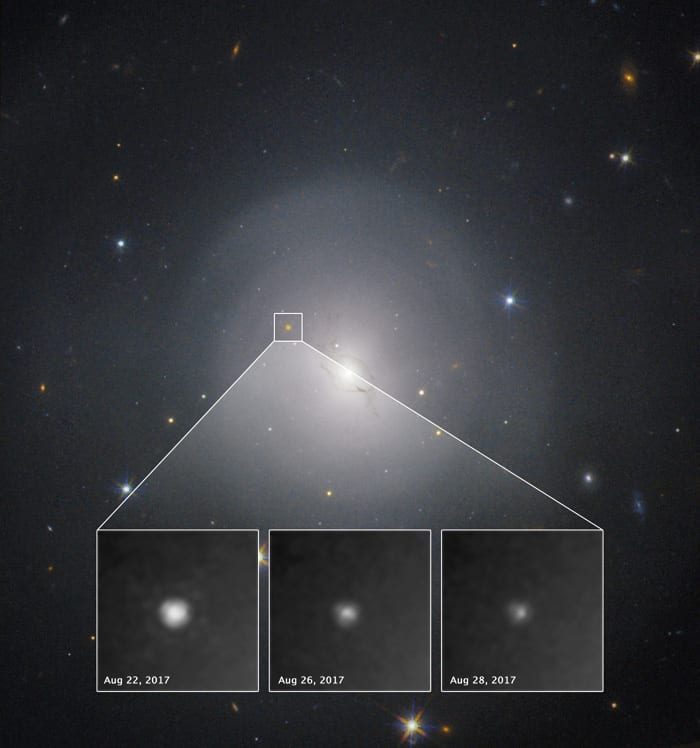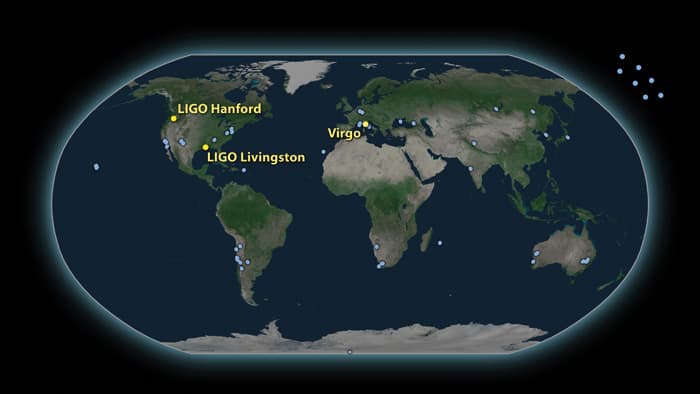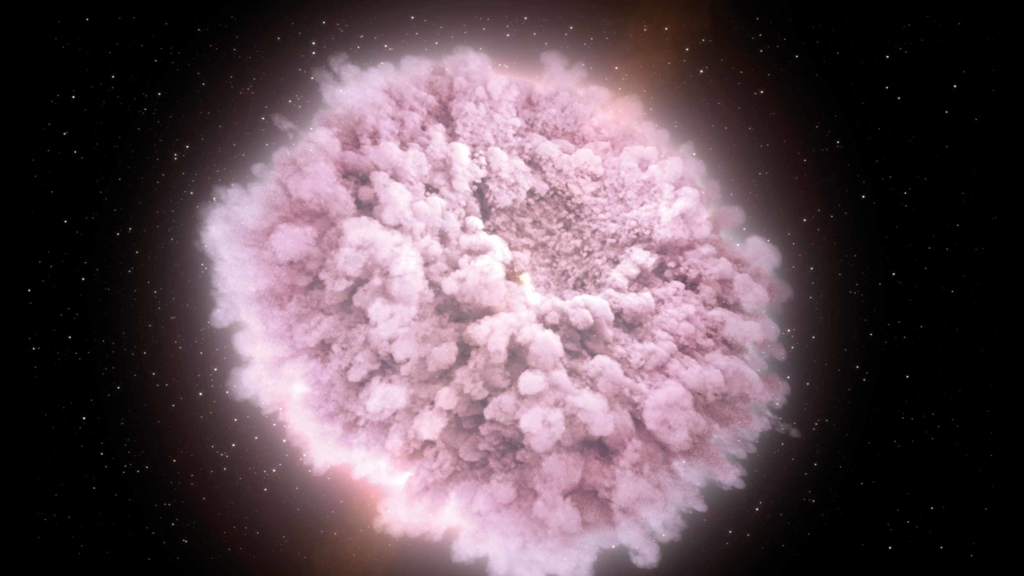The first observation of gravitational waves from two merging neutron stars that was recently made by the LIGO and Virgo detectors has – along with data from telescopes across the globe and in space – kicked off a new era in multimessenger astronomy. Imre Bartos describes this watershed moment, which crowned decades of research and will shape the future of observational astronomy
It was almost over. There was only one week to go before the Advanced LIGO and Virgo detectors would complete their observational run, and be shutdown for a year. Indeed, many of my colleagues from the LIGO–Virgo team were already on vacation, while I was awaiting relatives who were visiting. Then my phone buzzed. An automated text message, which read “ALERT FROM GWHEN | New event: G298048 | Check your email!” prompted me to rush to my computer, to look at the signal in a LIGO database. When a flurry of agitated phone calls from collaborators followed, it became clear that a historic moment was unfolding. We observational astronomers needed to act quickly, and as our findings were still a secret, I couldn’t even tell my relatives, who had arrived in the middle of the excitement, why I would need to work.
On 17 August 2017 the LIGO detectors in Louisiana and Washington detected gravitational waves from the collision of two neutron stars – ultracompact dead stars that weigh as much as our Sun, but are barely 20 km in diameter, roughly the size of Manhattan. Such an event had been anticipated for decades, but had never been observed until now. Within two seconds of the arrival of gravitational waves at LIGO, NASA’s Fermi Gamma-ray Space Telescope detected a short gamma-ray burst. This made it even clearer: the gravitational-wave detection – dubbed GW170817 – was not a false alarm, and observatories across the globe quickly needed to turn towards the direction of the collision, or the data would be lost forever. More than 70 telescopes and observatories around the globe and in space were rapidly notified, and were able to execute a co-ordinated survey of the merger and its aftermath, across the full electromagnetic spectrum – gamma-rays, X-rays, light, radio waves – and neutrinos. A new era in multimessenger astronomy had begun (figure 1).

Mixed messages
Until the turn of the 20th century astronomers relied on light to learn about the universe. But since the advent of radio astronomy in the 1930s, astronomers have expanded our view of the universe and we can now observe the cosmos across the full electromagnetic spectrum and by detecting other cosmic “messengers” such as cosmic rays, neutrinos and most recently gravitational waves. Multimessenger astronomy aims to combine information from all these cosmic messengers, to learn the most we can about distant phenomena. In general, each messenger carries complementary information about the source – be it a star, quasar or galaxy – and so multiple messengers provide a more complete understanding.
Apart from our Sun, the first cosmic phenomenon observed through multiple messengers was a supernova explosion in 1987. The event, named Supernova 1987A, occurred in our cosmic backyard, the Large Magellanic Cloud, some 170,000 light-years away. The explosion was so bright that it was visible to the naked eye. Apart from visible light, four different experiments, in Japan, Russia, the US and Europe, detected 25 neutrinos from the collapsing core of the dying star that produced the supernova.
Multimessenger searches involving gravitational waves began in the early 2000s when the twin LIGO observatories in the US began operating. By 2010 the global astronomy community had formed a broad network of telescopes, radio observatories, gamma-ray and X-ray satellites, and neutrino detectors to search for emissions from gravitational-wave sources. But for the first unambiguous detection, we had to wait until 2017.
Heavy pairs
Neutron stars are born during the cataclysmic collapse of very heavy stars. Matter in stars undergoes nuclear fusion, producing a variety of elements, the heaviest of which is iron, which sinks to the centre, forming an iron core. This core can eventually get so heavy that it collapses under its own weight, which occurs when the electric repulsion of atoms can no longer overcome the gravitational pull of the core. The collapse will be stopped by nuclear forces that become important once the density of the core reaches that of an atomic nucleus. The end result is a very compact, but heavy, dead star weighing about the same as our Sun. It is essentially a gigantic atomic nucleus, consisting primarily of neutrons; hence the name neutron star. The collapsing stars often end up creating a supernova.
Neutron-star collisions have long been one of the main targets of gravitational-wave searches. First, their small size and large mass make them very good producers of gravitational waves. Second, scientists already suspected that such collisions should occur frequently, thanks to the observation of gamma-ray bursts and binary neutron stars in our Milky Way. Sometimes, two neutron stars pair up to form a binary wherein they are gravitationally linked, and orbit each other in close proximity. In fact, most large stars in the universe were born together in binaries. When the stars in a binary collapse and explode as a supernova, they can both leave a neutron star behind, becoming a binary neutron-star system. Alternatively, independently formed neutron stars can encounter each other by chance and become gravitationally bound. This latter scenario can occur in locations with a large density of neutron stars, such as the centres of galaxies.

These bound, dense stars can orbit each other potentially for billions of years, but over time, this orbit slowly shrinks due to the emission of gravitational waves. This process also accelerates as the orbit reduces – right before neutron stars merge, they circle each other about a thousand times per second, at velocities comparable to the speed of light. This final dance, minutes before they finally fall into one another, produces a strong gravitational-wave signal detectable by LIGO and by Virgo in Italy. When neutron stars finally merge, they form an even heavier, rapidly rotating neutron star. This new object, however, is typically too heavy for nuclear and other forces to support its weight, and quickly collapses further. The end result is most likely a black hole.
Most material from the neutron stars forms the black hole, but some of the matter scatters during the merger. This matter forms an accretion disc around the central black hole, somewhat like Saturn’s ring, and is slowly consumed by the black hole. Indeed, as the material is sucked into the black hole, an energetic jet of particles is launched, which drives some of the material outwards and creates a burst of gamma rays. As the jet passes through interstellar gas, it slows down and produces afterglow radiation – first X-rays, then visible light, and finally radio waves.
The scattered material around the black hole also produces other more exotic forms of radiation. Neutron-star matter torn away during the merger are neutron-rich heavy nuclei, which are favourable for the formation of heavy elements. Some of these elements will be radioactive, and their decay will produce substantial amounts of radiation. This radioactive emission, known as a “kilonova”, was the dominant source of ultraviolet, visible and infrared radiation observed from the neutron-star merger.
Multimessenger discovery
The observation of the merger of two neutron stars through gravitational waves and throughout the electromagnetic spectrum was a process that lasted for weeks, and is, in fact, still an ongoing cosmic event. Following the first reports of the detection, there was an influx of news from around the world that provided a fascinating, real-time picture of the emerging phenomenon. Information on observations was shared between the thousands of scientists who were involved, with close to 100 collaborating observatories – the data collected by one detector or telescope helped another one point to the right part of the sky. There were as many as 200 electronic notices that distributed some kind of information about the detection.
To date, we have observed gravitational waves, gamma rays, X-rays, ultraviolet, optical, infrared and radio emissions from this neutron-star merger, and its aftermath. But equally interesting is what we did not observe – namely the highest-energy photons and neutrinos, with energies above one billion electron volts. This non-detection is informative of what happened following the collision, such as how the debris left behind from the neutron stars can act as an energetic particle accelerator. Scientists expect to continue detecting radio waves from the debris leaving the collision site for years, and so the story is far from over.
What did we learn?
The colliding neutron stars were a mere 130 million light-years from Earth, much closer than we previously anticipated for such an event. This proximity meant that we could observe radiation longer and in more detail, presenting a rich source of information. Scientists are still analysing the copious observational data, but some key findings are already clear.
Neutron-star mergers may be the main source of heavy elements in the universe. Elements heavier than iron, such as gold and platinum, can form only in a neutron-rich plasma. The current observation indicates that neutron-star mergers are suitable sites to produce most of the heaviest elements. For a long time, scientists suspected supernovae to be the key source, but this now seems unlikely.
The expansion of the universe can be measured by neutron-star mergers. If we know how far away a collision is, and at what redshift, it can be used to measure how fast the universe is expanding. Distance is measured using the gravitational-wave signal, and redshift is measured through the electromagnetic spectrum of the galaxy that hosts the stars. The obtained distance-redshift relation describes how fast the universe is expanding. Currently there are two other means to measure expansion: one uses supernova explosions, while another looks at the cosmic background radiation. The expansion rates calculated using these two techniques currently don’t agree, and we don’t know why. It will be exciting to see whether future gravitational-wave signals can arbitrate.
We have a new upper limit on the mass of neutron stars. We know that neutron stars cannot get arbitrarily large. At some point, the gravitational pull becomes too powerful to stop consuming the whole neutron star, which then collapses into a black hole. However, it was not clear just how heavy neutron stars can get before this happens. Previously, scientists thought that the upper limit on this was about 2.8 solar masses. But based on our observation of the collision and its aftermath, as well as sophisticated numerical simulations, we can now say that the maximum mass of a non-rotating neutron star can be no more than about 2.2 times the mass of our Sun. This limit is more meaningful as it is close to the mass of the heaviest neutron stars detected so far.
The neutron stars in GW170817 orbited each other for billions of years before colliding. NGC 4993, the host galaxy in which the collision occurred, shows no sign of star formation. This means that the stars that collapsed and gave birth to the neutron stars had to have been born a very long time ago, estimated in the billions of years. Very large stars live fast and die young, while smaller stars, like our Sun, live very long.
The colliding neutron stars created a gamma-ray burst. Scientists anticipated for decades that at least some of the short gamma-ray bursts we observe were created by the collision of two neutron stars, but this was the first time such a connection was unambiguously established.
There’s something strange about the energetic jet. The gamma-ray burst we observed from this merger is distinctly weaker, compared to previous detections, but why this should be so is a mystery. Also, we have no idea why there was a very long delay before we observed any X-ray and radio emissions, which are typically detected very soon after a gamma-ray burst. It is also interesting that no high-energy photons or neutrinos were observed from such a nearby event. It’s possible that the energetic jet is pointing away from Earth, such that we can see only from the “side”. Or perhaps the jet needs to burrow through debris around the merger remnant. The jury is still out.
Twice as nice
LIGO and Virgo are currently offline for about a year, during which time they will undergo a thorough upgrade that will make them more sensitive for the next period of observation. With their new sensitivity, they could end up detecting neutron-star and black-hole mergers at double the rate of the previous period, promising many exciting discoveries. The fact that we observed a neutron-star collision even with limited sensitivity means that we can expect to observe many more neutron-star collisions when LIGO’s sensitivity further improves.
Remarkably, the expected rate is in line with what we previously anticipated from other observations, such as those of gamma-ray bursts (of which the source is unknown) or simply observing binary neutron-star systems in our galaxy, long before they merge. Once LIGO and Virgo are updated and become twice as sensitive, the detectors should in turn be able to observe collisions at twice the current distance, corresponding to about 10 times the volume of the universe from which we can detect mergers. This means that we may see a neutron star collision every month.
A large number of detections means more fun, but we should also have a better handle on the current mysteries that surround neutron stars. More detections will also mean that we hopefully see some less common events as well, like a mixed merger of a neutron star and a black hole, which may provide useful insights about extreme phenomena in the universe.
The discovery of gravitational waves from the collision of two neutron stars, and the ensuing streak of electromagnetic detections, was a historic scientific moment that concluded decades of research and will be viewed as a new frontier in multimessenger astronomy. With any luck, the next few years will see a quickly growing number of discoveries that will expand our knowledge of the most extreme cosmic events and the evolution of our universe, as well as allow us to explore hypotheses in fundamental physics that are difficult to test on Earth. It will be a great journey that, with the advancement of data.
Timeline of a collision

–60 sec As yet unseen in visible light, gravitational waves from the inspiralling neutron stars start to appear in LIGO and Virgo data.
0 sec The two neutron stars merge.
2 sec The Fermi satellite discovers a gamma-ray burst.
14 sec The Fermi satellite sends out an automated message of detection.
6 min LIGO–Virgo software identifies a signal.
40 min Astronomy community is notified of gravitational-wave detection.
1 hr First neutrino results come in from the IceCube observatory – none were seen.
5 hr LIGO and Virgo gravitational-wave data are combined to make accurate map of source direction.
11 hr First optical detection reported by Swope Telescope, also identifying the host galaxy. Five other observatories take independent optical image of the event within an hour of Swope.
15 hr Swift satellite detects bright, ultraviolet emission.
17 hr Optical spectrum of the event is first measured by the 6.5 m Magellan Telescope.
9 days Chandra satellite reports observation of X-rays from the event.
15 days Radio emission is detected by the Very Large Array observatory.




